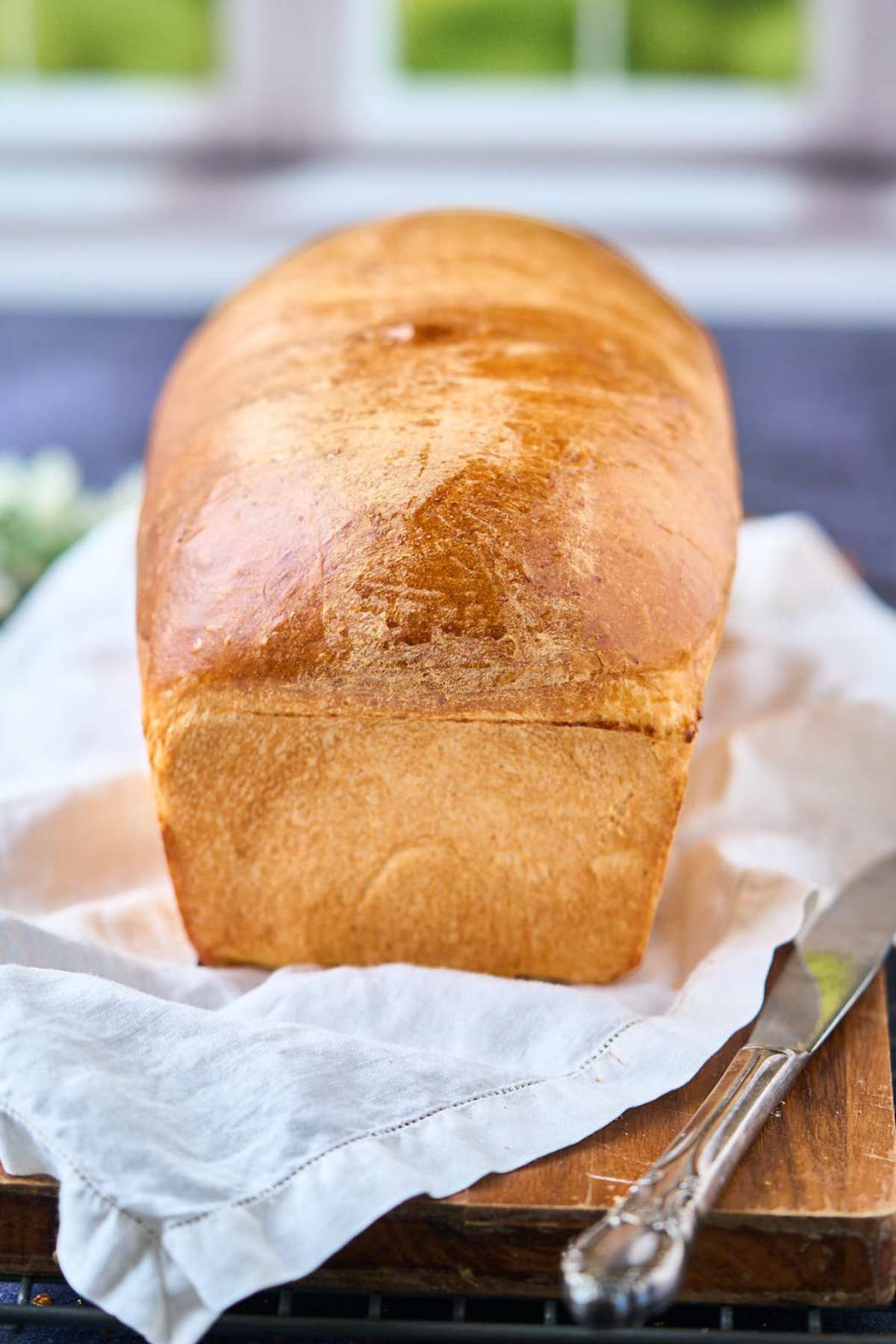7 Bread Baking Tips That Will Transform Your Loaves {But Really}
From instant yeast to machine kneading, these bread-baking tips will make you a pro.
It starts out the same for all of us. In your head, you’re pulling golden, shiny loaves from the oven. Your family is praising you! You’re never going to buy store-bought bread again. You are a true hero.
The reality of it all is…different. Your loaves are…flat? Everything’s a little dense. And your dough has never once, to your knowledge, actually doubled in size.
A Newsletter you’ll love
Daily recipes from the farmhouse, Sunday meal plans, seasonal ideas, straight from my kitchen to your inbox.
I promise to keep your email address safe. Unsubscribe at any time
That’s okay. Bread baking can be easy if you know the secrets. There are secrets.
Get ready to learn. Those fluffy, shiny loaves are right around the corner.

Bread baking can seem daunting, filled with weird terms and too many steps. Don’t worry. You’ve got this.
1. Use Instant Yeast
You can argue with me or you can buy some and be happy.
You can mix it straight into your flour. No need to dissolve it in water first. This saves time and makes the process simpler, especially for those new to baking.
One of the best things about instant yeast? It’s super reliable. If your house is a little too cool it will still work. If your milk is still a little chilly, it will still work. This means no frustrating moments of checking your dough only to see it’s done nothing.
You won’t need to fumble with little packets anymore, either. Buy a pound, pour it into a quart jar, and measure out what you need.
To sum it up, if you want to make bread baking easier and more predictable, instant yeast is a great choice. It’s quick, consistent, and lasts a long time.
2. Knead by Bread Machine or Stand Mixer
While there’s a certain charm and connection to the bread-making process when kneading by hand, using a bread machine or stand mixer offers several advantages.
The biggest one? If you knead by hand, it will take at least 20 minutes to get the dough to the correct stage. That is just crazy.
SAF Instant Yeast, 1 Pound Pouch (4 Pack)Amazon Basics 2 Pound Non-Stick Bread Making Machine, WhiteKing Arthur All Purpose Flour 5 Lb (2.27 Kg) Unbleached
And what usually happens is you start to think that it’s close enough after 10 minutes and you move on. But the gluten is not developed enough! And that’s why your loaves never achieve that perfect fluffy texture you want.
There are even more benefits of kneading by machine:
- Easier on your hands
- Less mess on your countertops
- You can easily double or triple batches
The best benefit, though, is that your loaves will have a better texture. Guaranteed.
3. But don’t bake in the bread machine. Like, ever.
One of the worst things about baking bread in a bread machine is the uniform, block-like shape that results. Additionally, the bread crust baked in a bread machine can sometimes lack the rich, golden-brown color and thin crust we all love.

Bread machines typically have a different heat distribution pattern than conventional ovens. This can lead to uneven browning or, in some cases, a thick and hard crust. An oven’s broader and more even heat distribution creates a crispy crust that gives way to a soft interior.
4. Be Willing to Adjust the Flour and Water
While we start with a recipe, various factors like humidity, the brand of flour, or even altitude can influence how our dough behaves. That’s why sometimes you might find the need to adjust the flour or water quantities to get the dough just right, even if you are measuring in grams.
If your dough feels too dense and heavy during the kneading stage, it can slow down the rising process. Think of it as giving the yeast more “work” to do in order to puff up the bread. This could be a sign that there’s too much flour in the mix.
On the flip side, a dough that’s too wet can be super sticky and challenging to work with. You’ll likely find it clinging to your hands, the bowl, and just about everything!
So, how do you strike the right balance?
- The Feel Test: When you’re kneading, the dough should feel soft, smooth, and slightly tacky but not sticky. If it’s sticking to your hands or the surface persistently (a little sticking is okay), you might need more flour. Add it a tablespoon at a time until you achieve the right consistency
- Adjust Gradually: Always adjust flour or water in small increments. It’s surprising how just a little more flour or a splash of water can drastically change the dough’s consistency.
- Trust Your Instincts: The more you bake, the more you’ll get a feel for what the dough should be like. Sometimes, it’s about trusting your instincts rather than rigidly sticking to the recipe.
5. Follow Your Recipe
You find a recipe for the softest, fluffiest bread, which calls for potato flakes and powdered milk. But you don’t have those. Since you want to eat more whole grains, you substitute some whole wheat flour. And now your loaf is dense and crumbly! What on earth could have happened?
You have now officially driven me to madness.
Function Over Flavor: While flavor is crucial, many ingredients serve functional roles. For instance, sugar isn’t just for sweetness; it contributes to moisture, texture, and browning.
Special Ingredients: Ingredients like powdered milk or potato flakes might seem unusual, but they’re in your recipe for specific reasons. Substituting or omitting these can dramatically change the bread’s texture and flavor profile.
Flour Dynamics: All flours are not created equal. Substituting whole wheat flour for white flour, for instance, doesn’t just change the flavor. Whole wheat flour has a different protein content and includes the bran and germ, which can affect gluten development and moisture absorption. This can result in a denser or crumblier product than intended.
Learning the Rules Before Breaking Them: While there’s room for creativity and innovation in baking, it’s crucial to understand the basics first.
6….But don’t be afraid not to follow it
However, one of the most invaluable skills a baker can develop is the ability to “read” the dough and bread, gauging its readiness by sight and touch rather than relying solely on a timer.
- Every Kitchen is Different: Your oven’s 350°F might differ slightly from someone else’s, and your kitchen’s humidity and temperature can vary from day to day. These factors can affect how quickly dough rises or how fast bread bakes. Thus, a recipe’s specified time is more of a guideline than a strict rule.
- Dough Behavior: Dough is a living entity, thanks to the yeast. It can be unpredictable. Sometimes, it might take longer to rise because of cooler temperatures, or maybe it got a slower start. If you strictly follow the clock and not the visual cues, you might end up baking dough that hasn’t fully risen, resulting in dense bread.
- Visual Cues Are More Reliable: There’s a reason many recipes include descriptors like “golden brown” or “doubled in size.” These visual markers are often more accurate gauges of doneness or readiness than time alone. A loaf that’s turned a beautiful golden hue with a crispy crust is a good indicator it’s done, regardless of whether it baked for 25 minutes or 30.
- Avoid Over or Under Baking: Solely sticking to a timer can lead to bread that’s still gooey in the middle or, conversely, overly dry and crusty. By keeping an eye on the bread’s appearance and occasionally testing it (like tapping the bottom for that hollow sound), you can ensure your loaf is baked to perfection.
- Developing Intuition: The more you bake, the better you’ll become at intuitively knowing when your bread or pastry is “just right.” This intuition, built over time and experience, can be more reliable than any timer.
While time is a useful guideline, it shouldn’t be the sole dictator of your baking process. Baking is a sensory experience. Engaging your senses, observing the color, feeling the texture, and even smelling the aroma will often lead to better results than merely watching the clock. Embrace the process, trust your instincts, and remember: sometimes, the best results come from deviating a little from the recipe.
7. Flour Quality Matters
Sure there are some liquids and a little salt and maybe some flavoring, but your loaf is almost all flour.
Buy a nice one! I like King Arthur, but it’s not the only good one.😊
Love,











Where could I get flour that is not sprayed with glyphosate?
King Arthur organic! Actually I think their regular is not sprayed with glyphosate either. They have a VERY helpful 1-800 number you can call 🙂
Wow! This website is amazing! Some day I fully intend on baking my own bread – and this is the know how and inspiration I need. I’m 68 and do not currently have a stove🙄. Imagine no additives, and using the quality of flour you want to.
thanks Donna! 🙂
One other point about sugar, I don’t know if this relates to fresh yeast only, but sugar checks the yeast.
My father was a baker and confectioner and was his favourite saying regarding yeast, sugar and bread baking.
One regarding pastry, if the pastry had pulled away from the pan then it was short. Short of fat.